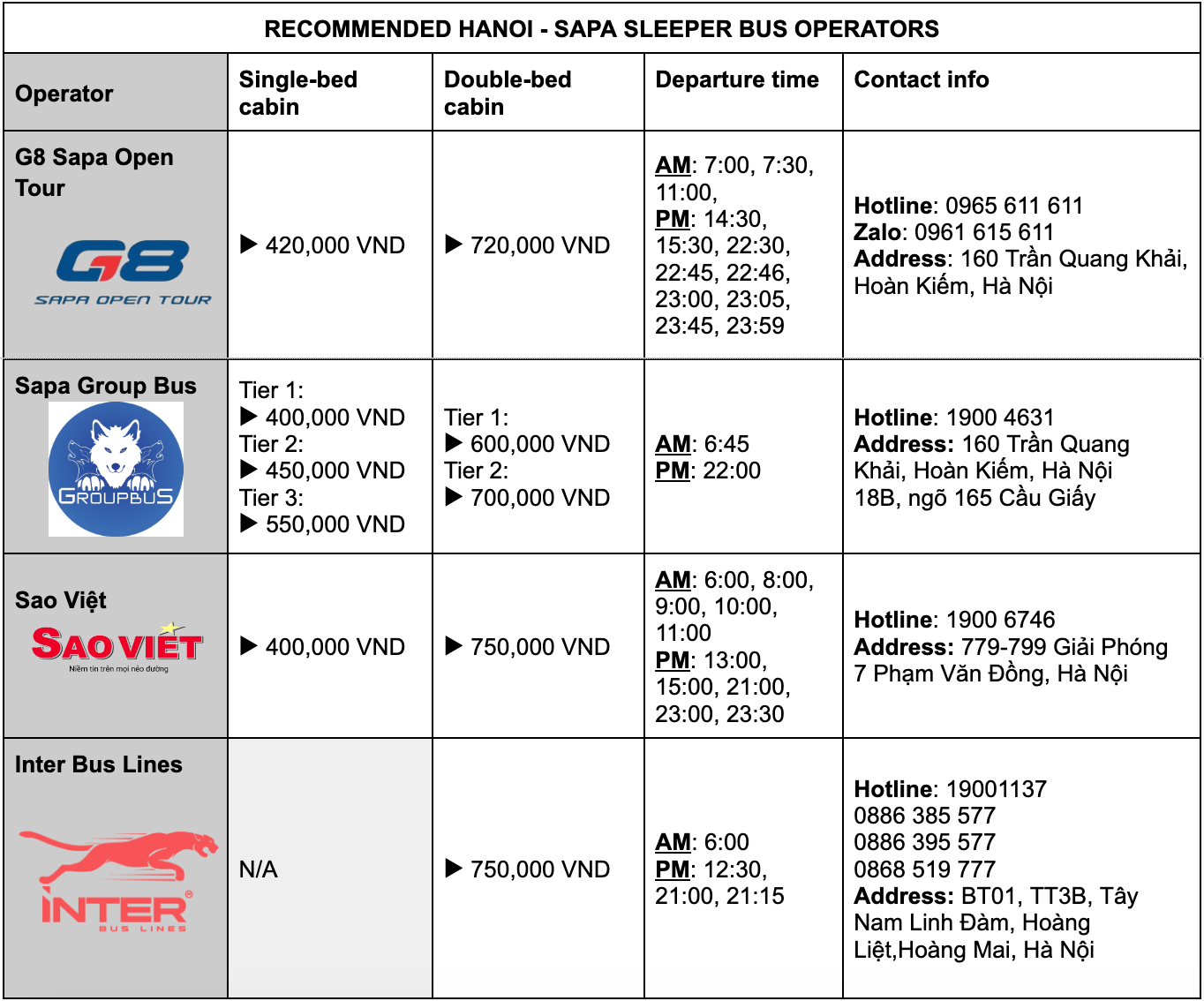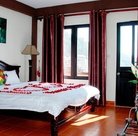How To Get From Hanoi To Sapa: 3 Best Ways To Travel
Ironically to every one of us as travelers, the least enjoyable part often seems to be the ‘travel' itself - as in transportation from one place to another. Vietnam’s breathtaking scenery and impressive terrains in the mountainous area of Sapa (Lao Cai), however, takes this challenge to another level.
Ironically to every one of us as travelers, the least enjoyable part often seems to be the ‘travel' itself - as in transportation from one place to another. Vietnam’s breathtaking scenery and impressive terrains in the mountainous area of Sapa (Lao Cai), however, takes this challenge to another level.
As flight is not an option, embark on this 350-km journey with us to explore exciting alternatives for reaching Sapa from the bustling capital city. Our comprehensive guide has you covered on all fronts – assessing pros and cons for each transport mode and providing insightful tips for booking, ensuring your experience is nothing short of delightful.

Sleeper Bus
What is a Sleeper Bus?
With every ticket purchased, you’ve got a private cabin for yourself, furnished with a reclinable bed, a pillow, a blanket, curtains and partitions between cabins, a TV screen (not smart TV), Wifi access (oftentimes unstable), a USB charging port and drinking water. Sometimes, if you find yourself lucky, headphones, reading lights, and even massagers are also parts of the package.
When you get on the bus, the driver or the conductor will hand you a bag for your shoes. There is a small compartment behind the bed to keep your shoes organized. All buses are AC-friendly and small adjustments on speed or fan direction can be adjusted separately in each compartment.
Ensure you're ready to roll 30 minutes before departure. Add 15 minutes to that as well if you opt for their pickup service.

Figure 1. A typical sleeper bus interior (Source: G8 Open Tour)
Pros
For those who are on a budget and tend to spend more on your Sapa experience rather than on transportation, buses are the most cost-efficient option out there with prices starting from as low as 400,000 VND (~ 17 USD) for a one-way ticket.
Equipped with comfy amenities and spending the least time on the road, sleeper buses are ideal for tourists seeking a tranquil nap before their next adventure on this short 6-hour drive.
These coaches are also more preferred among both local and foreign tourists as they offer relatively more flexible schedules than other options. You would have no trouble finding a schedule that works best for you from more than 30 sleeper bus agencies operating on the Hanoi - Sapa route, from early mornings to late nights.
Unlike train journeys, most bus lines allow you to show them an e-ticket on their app, via phone messages or email without the hassle of exchanging tickets at the station.
Cons
As there is no built-in WC on the bus, one or two public bathroom and snack stops are usually included on the road.
The bed may not offer generous legroom for those taller than 6” or 1.8m, yet you can always recline it to achieve your desired comfort. If you need more space, some buslines do offer couple cabins or couple beds. However, there have been instances of local people complaining these cabins are incapable of hosting two people as they are supposed to. Therefore, when it comes to space, it is always best to reserve one single bed for each person in your group.
Even after the booking site or the bus company has sent you an initial booking confirmation via email, make sure to constantly have your email inbox and spam inbox open, as it is very likely they change the bus plate number and the departure / arrival stop last minute without informing you through calls or texts.
Booking & Price
As Sapa has become increasingly popular among international tourists recently, most booking sites and hotlines are quite English-friendly and within 3-5 minutes you can easily make your booking online or via a short call to the service operator. You can also engage the service of your tour agent or your Sapa hotel to have them make the reservation on your behalf.
During your booking, remember to check the total number of seats available on the bus. If the number indicates 22-24 spots only, the bus you are choosing is exactly what we have been describing as a sleeper cabin bus; otherwise, 34-cabin buses are not recommended to foreigners as the legroom and privacy might fall short from meeting your needs.
Another thing to look out for is whether the destination is Sapa, especially when you see a cheaper ticket. You really do not want to be dropped off in the neck of the woods of Lao Cai, which is 55 km away from Sapa town.
With all that being said, here are some bus companies that are commonly chosen among international passengers.

Limousine Minivan
What is a Limousine Minivan?
Think of all you can get from a sleeper bus with a slight touch of luxury. This type of vehicle takes the form and shape of a 16-seat minivan from the outside and a design replicating a limousine ambiance from the inside.
The seats available, therefore, are way more limited. The scarer the seats, the higher the price, the more luxurious the experience (at least this is what the price indicates). Most limousine carriers offer 9-seaters and 11-seaters.
There are currently three most common seat arrangements on this type of vehicle, in order of most affordable to least affordable: (1) front seats by the driver, (2) VIP seats in the middle and (3) business-class seats at the back. The VIP and business-class seats are set apart, generously sized, equipped with adjustable armrests, and can recline as desired. Plus, passengers can enjoy an enhanced level of comfort with premium massage modes integrated into the seating.

Figure 2. A typical limousine minivan interior (Source: Phong Nha Locals)
Pros
For fellow travelers who would prefer to travel in groups, enjoy being picked up and dropped off at the door of your hotel, or simply share spaces with fewer people, a VIP limousine is definitely for you.
You do not have to rent the whole van for your trip. Sharing options are also available for limousines the same way as sleeper buses. While this is the case, if you are traveling in groups, consider reserving the whole van for your party. Not only can you enjoy the utmost privacy throughout your journey, but the cost per pax is also relatively lower while the transfer service can be made use of for the whole day. This means you have the liberty to choose your pick-up and drop-off time and place and have the minivan carry your group around Sapa till the end of the day.
The drivers are usually instructed to contact you with confirmation of the time and place for pick-up and drop-off, so there is no intermediary here. This eliminates any misunderstanding that might result in missing your bus as you can call your driver any time.
Cons
To accommodate such privacy and convenience, the biggest setback a limousine poses lies in its less affordable ticket price, especially in comparison with a sleeper bus.
Also, this choice of vehicle barely offers any late-night drive. This precaution is likely aimed at enhancing road safety for both drivers and passengers, given the demanding topography along the Hanoi to Sapa route, which may pose challenges for less experienced drivers. Generally, there are two to three trips in the morning and another two to three in the afternoon.
Booking & Price
Contacting the operator directly is usually the fastest way to secure a seat on a minivan. They will inform you which schedule and seat are available, which pickup point is the most suitable from your hotel, the plate number of the van and the number of the driver.
Have a look at some options we highly recommend below to get you started.

Tourist Train
What is a Tourist Train?
The journey from Hanoi to Lao Cai by train features a variety of passenger coaches, each boasting standard and premium services. The latter, curated by independent coach providers, transforms regular cabins into elegant hotel rooms for tourists seeking to elevate the short trip to a VIP experience.
There are two types of coach available on the train: 2-berth beds and 4-berth beds. If sharing a cabin with strangers feels uncomfortable, you can opt to book the entire cabin for your own peace of mind.

Figure 3. A typical interior design inside a premium coach (Source: King ExpressTrain)
Pros
The vintage charm of this over-one-decade-old mode of transportation is completely undeniable. A sense of nostalgia becomes apparent as you stroll along the train hallway which is adorned with classic design and timeless features since its inauguration in 1885. To some, boarding this train isn't just a journey; it's a step into history.
Another reason why most tourists select trains as their preferred means to reach Sapa is because trains are also considered safer on the road. The accommodation on train is also more accessible with built-in sinks and toilets for each coach and especially comfy beds with enough room to stretch your legs.
Cons
Regardless of its historic appeal, trains seem to be the least favorite picks among tourists seeking for a way to reach Sapa from Hanoi as not only is the travel time extended, the journey can also be a bumpy and noisy one. For those who treasure their beauty sleep, we strongly advise considering an alternative mode of transportation if you happen to be a light sleeper.
The availability of departure schedules is also somewhat constrained. Whether you choose a basic or premium package from any compartment service provider, trains departing from Ha Noi Station to Lao Cai Station offer only two daily standard departure times: 21:35 and 22:00.
Note that the train voyages are said to take 8 hours. This might suggest a 10% chance to relish the scenery, typically between 5 to 6 in the morning, overshadowed by 80% presence of rattling tree branches, bed shaking, darkness, and 11-12 train stops throughout the journey.
A lot of tourists have also mistaken their train vouchers / booking confirmation for the train tickets or boarding passes. After receiving your booking confirmation, you would either receive the e-ticket via your email prior to your departure in the event that the tourist train service states so in their policy. Otherwise, there is a good chance you will have to exchange it at the designated station booth by showing your proper identification paper and booking code.
Booking & Price
It's crucial to understand that when traveling by train on this route, the train makes its stop in Lao Cai, not Sapa. It takes another one and a half hour by car to reach Sapa from the station.
Therefore, if you are booking your tickets directly on the official train operator Hanoi Railway Transport Joint Stock Company’s website, tick into the box below for an added shuttle service to Sapa. The extra cost is 55,000 VND (~$2.5) per person.

Figure 4. Shuttle bus service provided by the official train operator (Source: dsvn)
Alternatively, if possible, arrange for your Sapa hotel to coordinate a shuttle transfer or a private car on your behalf. This guarantees your safety against any taxi-related scams, as the driver will navigate you to the correct hotel.
Now that you have secured your booking, it is time to board your train. The first thing to do at the station is to find the large display screen discerning the platform of your train. On your tickets, you will be able to find details of your coach and seat/bed numbers as well.
When catching a train, bear in mind that there is no dining carriage available, and anything that is not handed to you by your chosen travel agent or not available inside your compartment is not complementary. Always keep your valuables with you when exiting your cabin because you can only secure it from the inside; external locking is not possible as there is no key.
Take your pick from a few trusted cabin providers below.

Things to note as you travel on the road
- (1) Have your passport with you all the time throughout your journey. As a foreigner, you can be asked by the conductor to show your identification together with tickets before boarding.
- (2) In terms of payment method, most operator companies allow instant-booking payment made through debit / credit cards issued by Mastercard, VISA, or JCB, e-wallet apps connected with a Vietnamese phone number, internet banking and QR transfer via Vietnamese banks. Some bus companies even have a policy to let passengers pay at the station 15 minutes before departure.
- (3) Always take the time to find the official site or social account of the service provider. Do not register your debit / card information on a site that is not up-to-date, sketchy looking, or with different name variations.
- (4) If you are making a reservation through an agency, kindly request the representative to provide you with all pertinent ticket vouchers, e-tickets, or boarding passes. Additionally, maintain regular communication with them as your boarding time approaches. It is imperative to keep their services in mind for potential emergencies.
- (5) Pay attention to the cancellation policy, as it can vary from one site to another. If you are uncertain about your upcoming travel plan, we recommend booking on trusted popular sites like Vexere, Traveloka and Klook as they have a more consistent cancellation and refund policy regardless of the service provider.
- (6) Take pictures of your vehicle’s plate number before taking off for toilets or refreshments as there are hundreds of other buses and minivans that look exactly like yours at the public stop.
We hope you can now embrace the allure of Sapa to the fullest with our handpicked recommendations and insider tips. All that remains now is to relish every moment amidst the breathtaking landscapes and immersive local culture that awaits you on your Sapa adventure.
Insiders’ Advice
-
 5 must-go places in Sapa
5 must-go places in Sapa
-
 Best time to visit Sapa
Best time to visit Sapa
-
 Five best hotels in Sapa
Five best hotels in Sapa
-
 How to exchange ticket at Hanoi train station
How to exchange ticket at Hanoi train station
-
 How to get to Sapa
How to get to Sapa
-
 What to see in Sapa
What to see in Sapa
-
 Train or Bus - Choosing the best way to get to Sapa
Train or Bus - Choosing the best way to get to Sapa
-
 5 Best Overnight Trains From Hanoi To Sapa: Budget to Luxury
5 Best Overnight Trains From Hanoi To Sapa: Budget to Luxury
-
 What to do in Sapa
What to do in Sapa
-
 Bac Ha weekend market
Bac Ha weekend market
-
 Homestay in Sapa
Homestay in Sapa
-
 Trekking in Sapa
Trekking in Sapa






